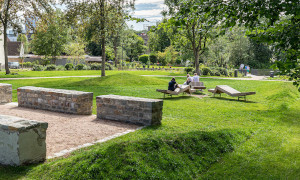Do we still dare to create visionary designs today?
By Stephan Lenzen
At a hearing of the associations in the Ministry of the Interior on the topic of the reorientation of urban development funding, I was told in response to my demand for stronger integration of climate adaptation measures in the programmes that climate adaptation of cities is not fundamentally a green topic, i.e. not an original landscape architecture topic. Yes, it is clear that, given the complexity, integrative planning approaches are needed. But how can the profession succeed in positioning itself more strongly in the public eye on the subject of climate change?
In their book, 2°C, Chris Rapley and Duncan Macmillan sum it up: "The real point about climate change and its impact on the human living environment is that while climate change has been uncovered by science, it is not about scientific questions, but ultimately about one question: what kind of world do we want to live in?"
What this means for landscape architecture is that it needs to clearly articulate what kind of future we want to create, especially for cities. We should finally develop and publish overall green concepts for our cities and not leave the term Green City to the technical answers to climate adaptation.
As generalists, we should have the courage to put on the "planning hat".
Stephan Lenzen
While I continue to believe that it takes a team of planners to address these pressing issues. However, as an adequate generalist, we should have the courage to put on the "planning hat." Almost all of the components of urban resilience are individually our areas of expertise, but we all too rarely and usually quietly bring them together.
We plan for green infrastructure. It is our open spaces that are fresh air corridors and cold air production zones. It is our open spaces where health sports and exercise take place. We plan infiltration areas and issue flood proofs. We plan green roofs and facades, the new mobility routes, the cycle paths. We carry out participation processes and last but not least, even if we almost neglect them, we have the plant knowledge.
But do we still dare to make these grand visionary designs today? I have the feeling that rich Germany, of all countries, has lost the positive utopias.
Ulrich Schnabel writes in his new book "Zuversicht. The Power of Inner Freedom and Why It's More Important Today Than Ever": "Instead, backward-looking 'retrotopias' dominate, as the social philosopher Zygmunt Bauman has called them - 'visions that, unlike their predecessors, no longer feed on a future that is still to come and therefore inexistent, but on the lost/robbed/orphaned, in any case undead past' - in other words, retro- instead of utopias."
Perhaps what we lack most with regard to the future is the motive power of confidence, and thus the basic fuel of life. Confidence, then, does not mean cherishing illusory hopes, but keeping a clear view of the seriousness of the situation. At the same time, however, confidence also means not allowing oneself to be paralysed, but rather making use of the free spaces that open up - no matter how small they may be.
We should add our own model of the living environment of the future to the models of the Morgenstadt, which always paint pictures of a green future for cities - but are based on a purely technical and digital world. It is the beautiful and wonderful thing about our profession that it is extremely meaningful.
Author: Stephan Lenzen, Landscape Architect bdla, RMP Stephan Lenzen Landscape Architects, Bonn, bdla Vice President. The text appeared in the bdla association magazine "Landschaftsarchitekten" 4/2019.
- Latitude: 0
- Longitude: 0


